Discover 15 hidden attractions, cool sights, and unusual things to do in Norwich (United States). Don't miss out on these must-see attractions: Senator Thomas J. Dodd Memorial Stadium, Slater Memorial Museum, and Yantic Woolen Company Mill. Also, be sure to include Cathedral of Saint Patrick in your itinerary.
Below, you can find the list of the most amazing places you should visit in Norwich (Connecticut).
Table of Contents
Senator Thomas J. Dodd Memorial Stadium
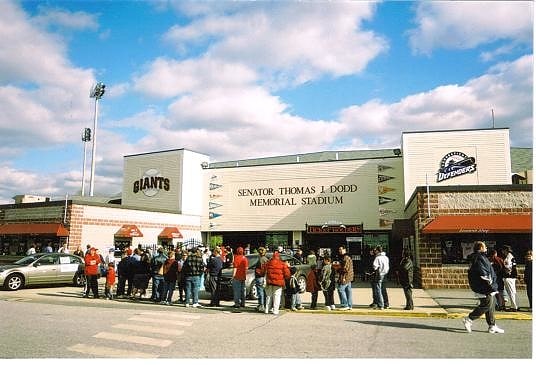
Stadium in Norwich, Connecticut. Senator Thomas J. Dodd Memorial Stadium is a stadium in Norwich, Connecticut. It is primarily used for baseball, and since 2010, has been the home of the Norwich Sea Unicorns, who were previously known as the Connecticut Tigers. It was the home field of the Connecticut Defenders minor league baseball team until 2009 when the Defenders announced their move to Richmond, Virginia to become known as the Richmond Flying Squirrels. It was built in 1995 and has a seating capacity of 6,270. It is named for Eastern Connecticut native Thomas Dodd who was a United States Senator and Representative from Connecticut, and the father of U.S. Senator Christopher Dodd.[1]
Address: 14 Stott Ave, 06360 Norwich
Slater Memorial Museum
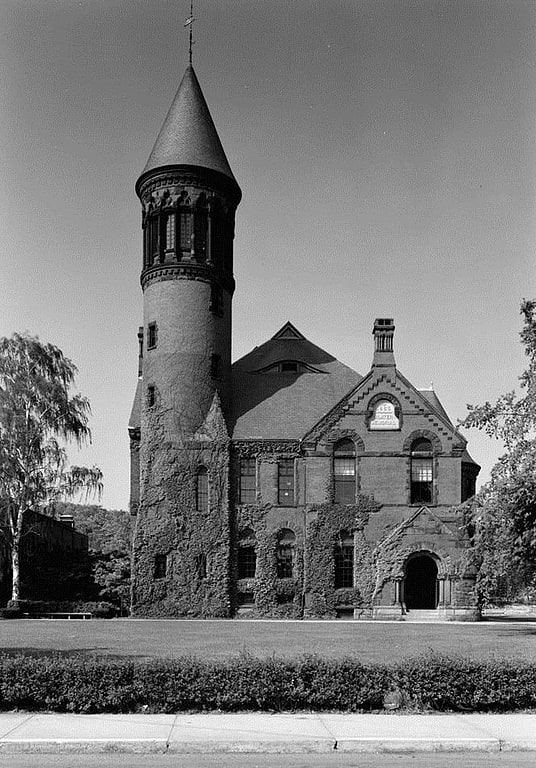
Museum in Norwich, Connecticut. The J. F. Slater Memorial Museum, also known as Slater Memorial Museum, is an historic building and art museum on the grounds of the Norwich Free Academy in Norwich, Connecticut, built in 1885 and dedicated in 1886. It is designed in Richardsonian Romanesque architecture and is said to be the finest work of architect Stephen C. Earle.
It is a contributing property in the Chelsea Parade Historic District.
The museum was presented to the Norwich Free Academy by William A. Slater, son of John Fox Slater, who had endowed the school.
The museum features a collection of plaster casts of famous Roman, Greek, Egyptian and Renaissance statues. The museum also exhibits colonial and local historic artifacts, as well as 18th-to-20th-century American paintings and decorative arts, 17th-to-19th-century European paintings and decorative arts, African and Oceanic sculpture, and Native American objects. The adjacent Converse Art Gallery hosts six changing exhibitions throughout the year. The gallery, built in 1906, was designed by the leading local firm of Cudworth & Woodworth.
The museum is a member of the North American Reciprocal Museums program.[2]
Address: 108 Crescent St, 06360-3556 Norwich
Yantic Woolen Company Mill

The Yantic Woolen Company Mill, also known as the Hale Company Mill, is a mill complex located at the junction of Chapel Hill and Yantic Roads in northwestern Norwich, Connecticut. Built in 1865, the stone mill is a well-preserved example of mid-19th century textile mill architecture, and was the major economic force in the village of Yantic, where it stands. The mill was listed on the National Register of Historic Places on July 25, 1996.[3]
Address: 151 Yantic Rd, Norwich
Cathedral of Saint Patrick

Cathedral in Norwich, Connecticut. The Cathedral of Saint Patrick in Norwich is a cathedral of the Roman Catholic Church located in Norwich, Connecticut. It is the mother church of the Diocese of Norwich and is the seat of its prelate bishop.[4]
Address: 213 Broadway, 06360 Norwich
Downtown Norwich Historic District
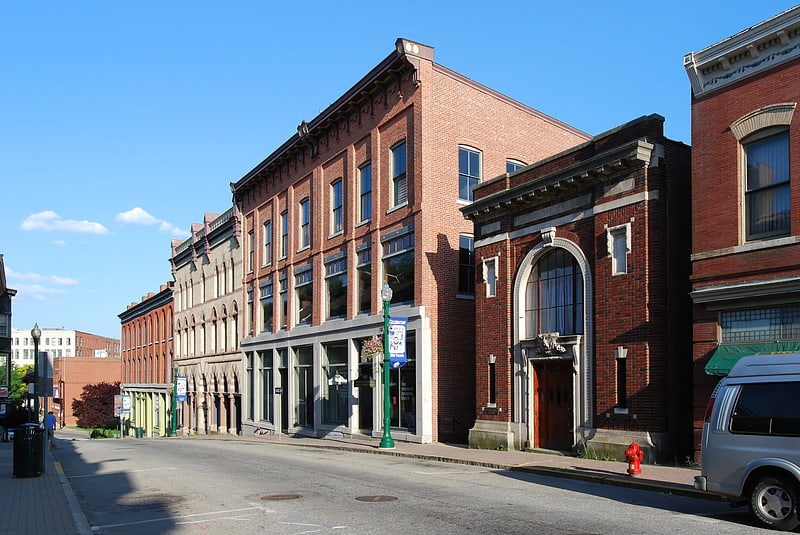
The Downtown Norwich Historic District is a historic district representing the core of the downtown area of the city of Norwich, Connecticut in the United States. It was listed on the National Register of Historic Places in 1985. It includes 115 contributing buildings and one other contributing structure over a 64-acre area. Several buildings in the historic district are also individually listed on the National Register, including the Norwich Town Hall, the Telephone Exchange Building and the Carroll Building.
Norwich was settled by English colonists in the 17th century, and its first wharf was built in 1684. It developed rapidly as a shipping port, with economic activity focused near the waterfront at the confluence of the Shetucket, Yantic, and Thames Rivers. The downtown developed as a linear area just north of the main port area, Main Street forming an east–west axis. The oldest surviving commercial building dates to 1742, and the oldest house to 1745. A major fire in the downtown in 1793 encouraged a shift to brick construction, but growth was squelched by the economic blockades associated with the War of 1812. The downtown's architecture is consequently dominated by Greek Revival andlate 19th and early 20th century architecture, which was built when the city was an important point for the transshipment of goods by either rail or ship. By this time, the city's economy had diversified to include banking, textiles, and other water-powered industry. The downtown area includes many intact 18th and 19th-century buildings centered on the now-picturesque harbor.[5]
Norwich City Hall
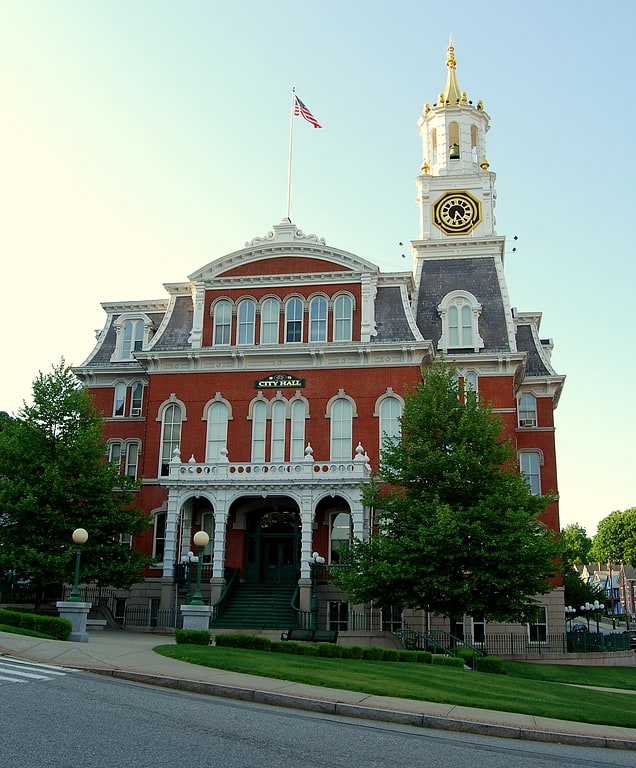
City government office in Norwich, Connecticut. Norwich City Hall is the seat of municipal government in Norwich, Connecticut. It is located at Union Street and Broadway, prominently overlooking the city's central business district. Built in 1870-73, when Norwich was still a town, it has served as the seat of municipal government since then. Architecturally it is a prominent statewide example of civic Second Empire architecture, and was listed on the National Register of Historic Places in 1983 for its architecture and history.[6]
Leffingwell Inn
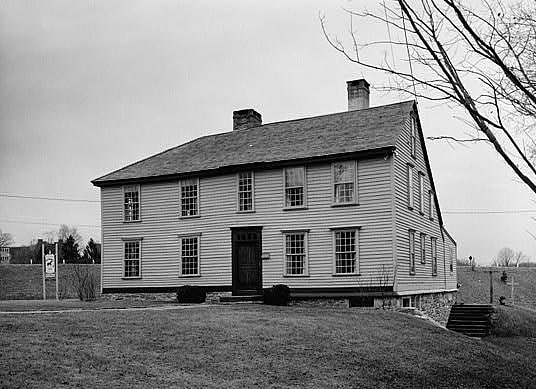
Inn. The Leffingwell Inn is a historic inn at 348 Washington Street in the Norwichtown section of Norwich, Connecticut. With a construction history dating to 1675, it is one of Connecticut's oldest buildings, and was an important meeting place during the American Revolutionary War. The building was listed on the National Register of Historic Places in 1970.[7]
Converse House and Barn

The Converse House and Barn are a historic residential property at 185 Washington Street in Norwich, Connecticut. Built about 1870 for a local businessman and philanthropist, it is a prominent local example of High Victorian Gothic architecture. The property was listed on the National Register of Historic Places in 1970, and is included in the Chelsea Parade Historic District.[8]
Nathaniel Backus House
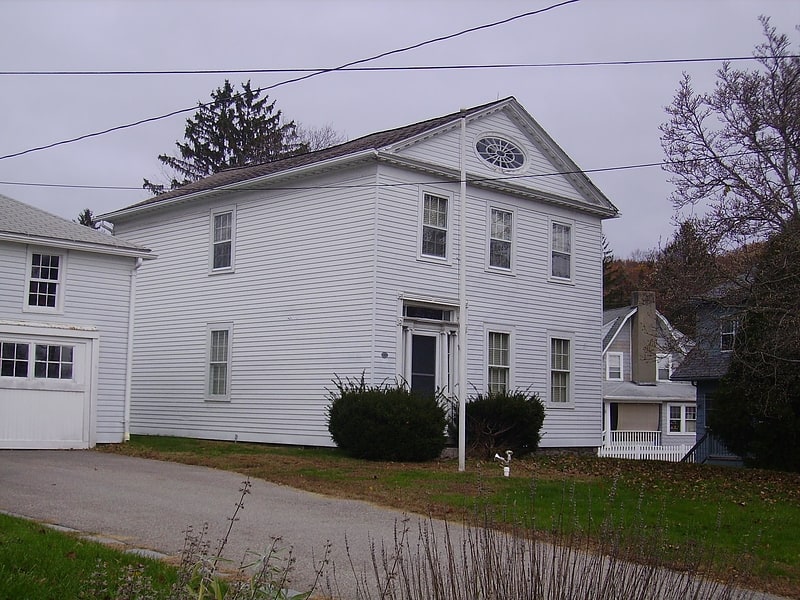
Museum in Norwich. The Nathaniel Backus House is a two-story Greek Revival clapboarded house with a gable roof in Norwich, Connecticut. The house was built around 1750 by Nathaniel Backus and served as his home, it was later moved to its current location in 1952. The house originally began as a Colonial, but was greatly modified to Greek Revival around 1825, reconfiguring the central door to the left of the facade and adding two chimneys. The house is a historic house museum operated by the Faith Trumbull Chapter of the Daughters of the American Revolution.
The Nathaniel Backus House was submitted to the National Register of Historic Places for its historical value in local history and as an example of Greek Revival domestic architecture. It was listed on the National Register of Historic Places (NRHP) in 1970 and was also included in the Chelsea Parade Historic District in 1989.[9]
Carroll Building
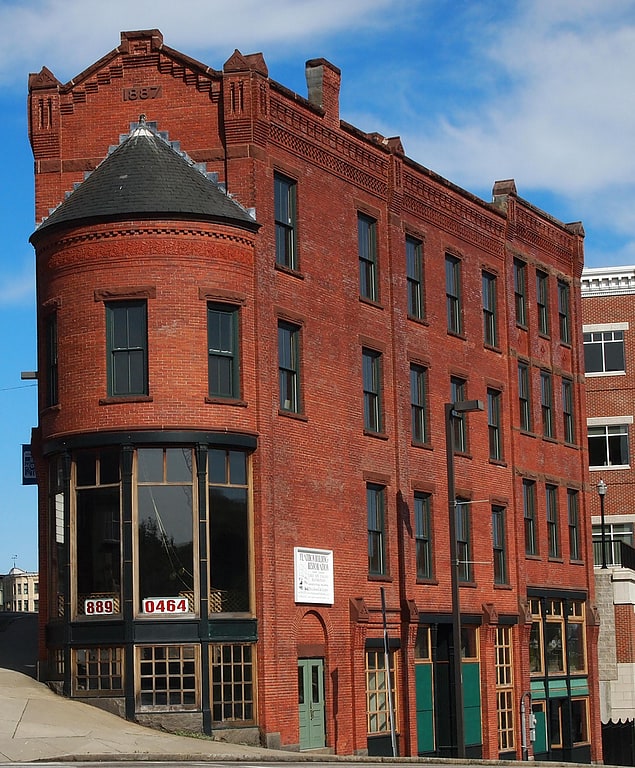
Building in Norwich, Connecticut. The Carroll Building in Norwich, Connecticut, also known as the Flat Iron Building, was built in 1887. It was listed on the National Register of Historic Places in 1982. It is included in the Downtown Norwich Historic District, which is also listed on the NRHP. Originally used as offices and retail stores, the building is now currently used primarily as an apartment building. The Carroll Building is located on a triangular tract created by the intersection of Main and Water Streets. The building is highly visible from Washington Square and is one of the most noticeable aspects of the downtown streetscape. The building is currently vacant.[10]
Jail Hill Historic District
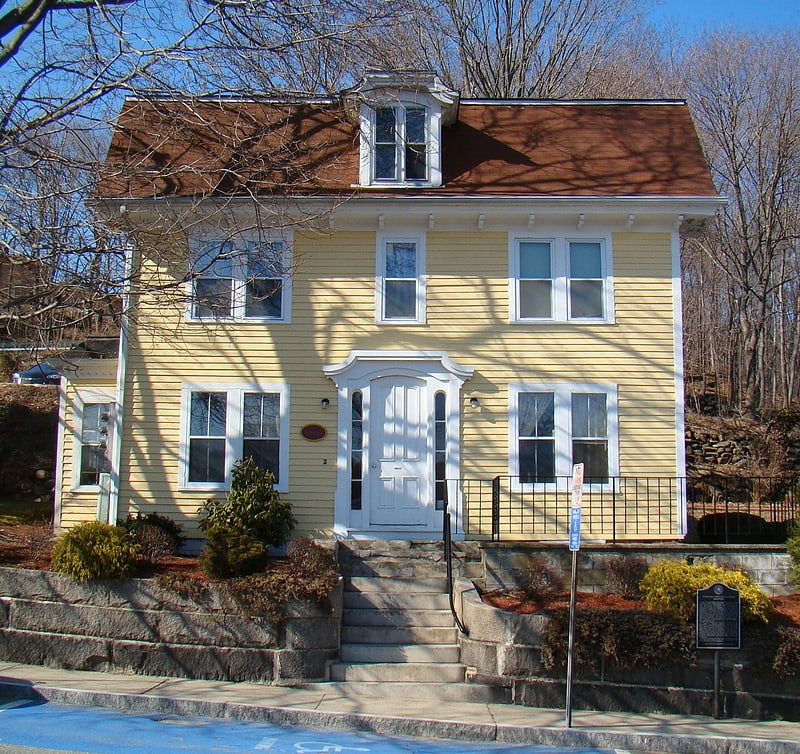
The Jail Hill Historic District encompasses a 19th-century working-class residential district in Norwich, Connecticut. Located on a steep hill overlooking downtown Norwich, it was populated first by African Americans, and then by Irish immigrants. Some early African-American residents played significant roles in bringing expanded rights and education to others. The district was added to the National Register of Historic Places on April 19, 1999.[11]
Yantic Falls Historic District
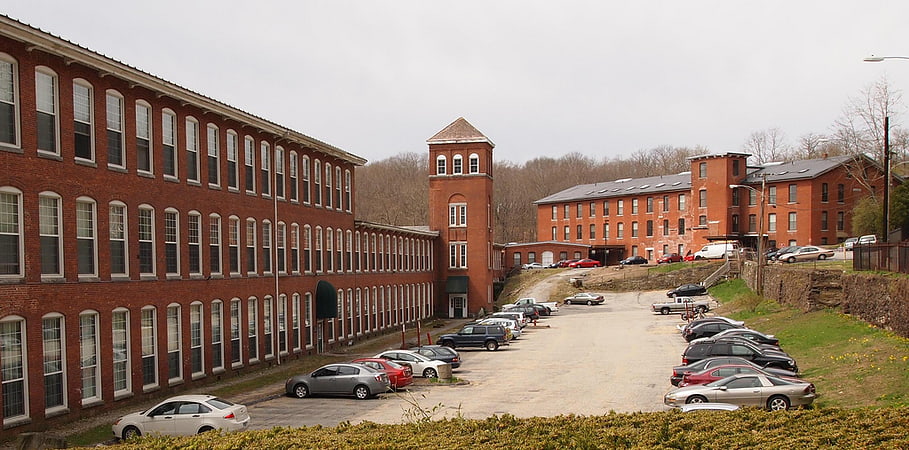
The Yantic Falls Historic District encompasses a historic mill and associated worker housing on Yantic Street in Norwich, Connecticut. The 10-acre area includes a complex of mill buildings, mainly built in brick, and mill worker housing, also out of brick. The area's industrial history dates to the early 19th century. The district was listed on the National Register of Historic Places on June 28, 1972.[12]
Telephone Exchange Building
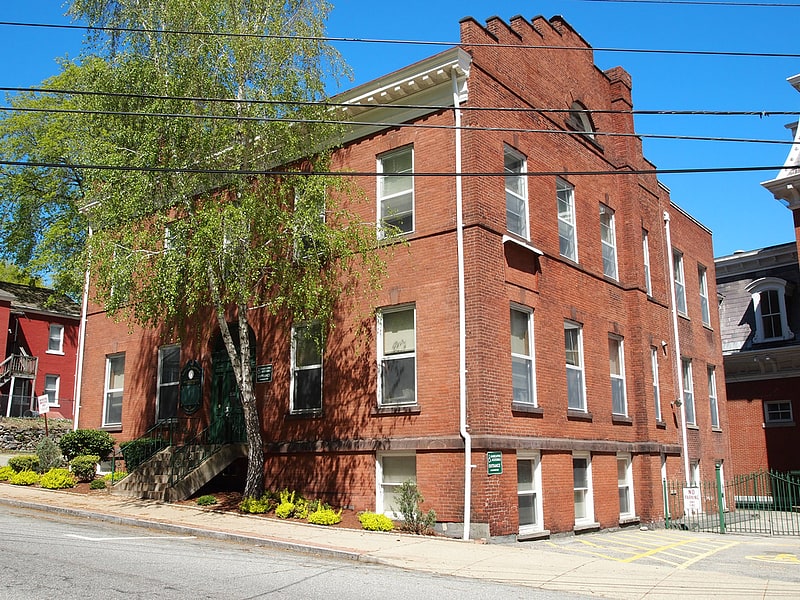
The Telephone Exchange Building is a historic building at 23 Union Street in downtown Norwich, Connecticut, behind Norwich Town Hall. Built in 1906-07, it was the first purpose-built telephone exchange building in the city, and is a little-altered example of period exchanges built by the Southern New England Telephone Company. The building now houses city offices. It was listed on the National Register of Historic Places on November 28, 1983.[13]
William A. Buckingham House
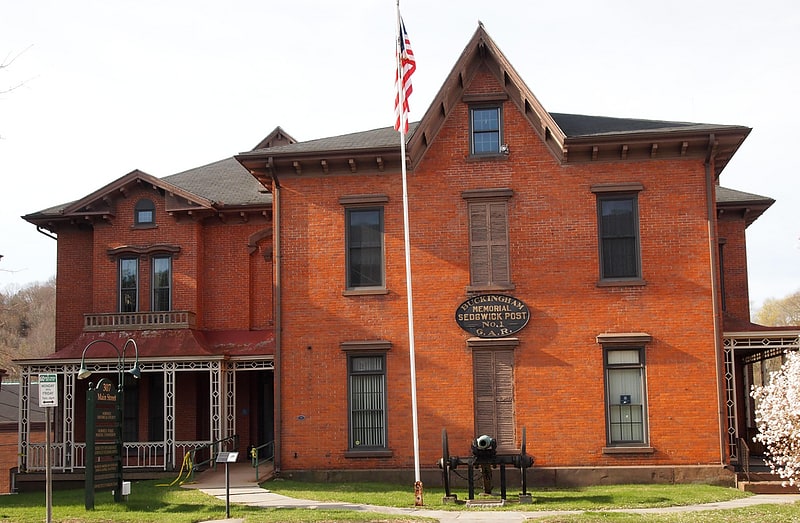
The William A. Buckingham House, also known as Buckingham Memorial Hall, is a historic house a fraternal hall at 307 Main Street in Norwich, Connecticut. It was built in 1847 by William A. Buckingham, whose later political career included terms as mayor of Norwich and Governor of Connecticut. Since 1898, it has housed a variety of veterans' and other service organizations, as well as government offices. The house was listed on the National Register of Historic Places on April 29, 1982.[14]
East District School

The East District School is a historic school building at 365 Washington Street in Norwich, Connecticut. Built in 1798, it is significant as a rare and well-preserved 18th-century schoolhouse, and as the location of an evening school for adults established by Consider Sterry, author of an early guide to practical navigation. The school was listed on the National Register of Historic Places in 1970, and is a contributing property to the Norwichtown Historic District.[15]